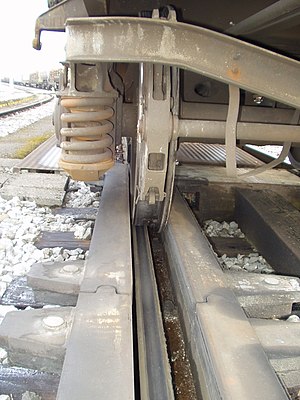Retarder (railroad)



In rail transport, a retarder is a device installed in a classification yard used to reduce the speed of freight cars as they are sorted into trains.
Construction
Each retarder consists of a series of stationary brakes surrounding a short section of each rail on the track that grip and slow the cars' wheels through friction as they roll through them.[1]
Computer control
Modern retarders are computer controlled to apply a precise amount of pressure on the wheels so that cars rolling down a yard's hump are slowed to a safe speed for coupling with cars already standing on the yard's tracks.[2]
Inert retarder
An inert retarder holds a cut of classified railcars to keep them from rolling out of a yard.[3]
See also
References
- ^ "Safety at the Switches". Popular Science Monthly. 107 (4). New York: Popular Science Publishing Co.: 38 October 1925.
- ^ Boyd, Jim (2001). The American Freight Train. MBI Publishing. p. 63. ISBN 978-0-7603-0833-2.
{{cite book}}: Cite has empty unknown parameter:|coauthors=(help) - ^ U.S. Federal Railroad Administration, Washington, D.C. (1983). "Definitions: Inert retarder." Railroad Noise Emission Compliance Regulations. Code of Federal Regulations, 49 CFR 210.5.
